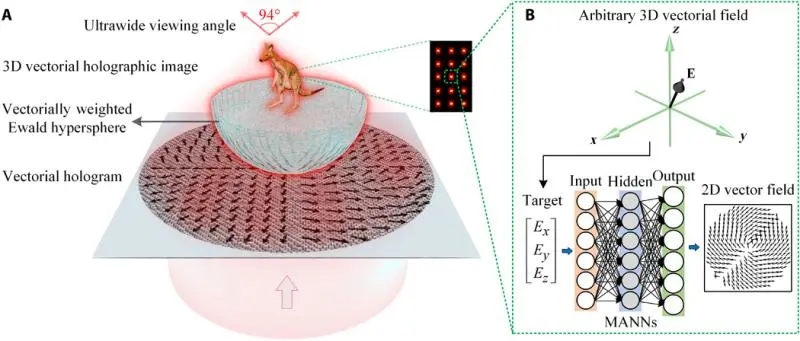Millions of university students in Optics courses learn how electromagnetic light waves can physically propagate through a 3D space, with its electric and magnetic field vectors pointing in different 3D directions. But a light beam is most commonly considered as a transverse wave, where its electric and magnetic field vectors pointing in a 2D plane perpendicular to the direction of propagation. Finding a way to precisely manipulate 3D vectorial fields with its vector pointing in any desired 3D directions has remained a major challenge today.

A team of researchers from Australia (RMIT University), China(University of Shanghai for Science and Technology), and Germany(Ludwig Maximilian University of Munich) has now reportedly used machine-learning inverse design approach to creating and manipulating arbitrary 3D vectorial fields of laser light. This research has been published online by the journal Science Advances.
“Recent years have witnessed a growing interest from photonics researchers in transforming previous knowledge-based forward design into machine-learning-assisted inverse design,” states Min Gu, the Executive Chancellor and Professor at the University of Shanghai for Science and Technology and a foreign fellow of the Chinese Academy of Engineering.
“This machine-learning approach based on a trained computer has allowed us for the first time to access to any on-demand 3D vectorial fields, which is beyond people’s knowledge and capabilities,” Gu added.
Machine learning is a branch of computer science which learns from data experience, and it can predict outcomes of questions based on previous learning.
“Machine-learning inverse design has made a great impact on photonic design with previously unattainable functionalities and performance,” said the lead author, Dr. Haoran Ren, currently a Humboldt Research Fellow at Ludwig Maximilian University of Munich in Germany.
What we’ve managed to do is use machine-learning inverse design to provide precise and instant prediction of any 3D vectorial fields on-demand that will allow us for the first time to realize optical holography using 3D vectorial fields,” Ren said.
The team worked with computer scientists to use trained multilayer-perception artificial neural networks to statistically learn and instantly solve the complex inverse problem of 3D vectorial holography, and each pixel of a displayed holographic image carries an individually-controlled 3D vectorial field.
“The 2018 physics Nobel Prize recognized the invention of optical trapping. Our demonstrated 3D vectorial holography may provide a useful tool to precisely design and dynamically tailor on-demand 3D trapping force inside a single optical trap or among multiple traps,” Gu said.
As well as laying the foundation for 3D vectorial holography and providing an artificial intelligence platform for holographic applications, the research offers a precise new method for improving scientific understanding of light-matter interactions based on 3D vectorial fields.
“Our method may open new avenues to widespread information technologies such as 3D holographic displays, multi-dimensional data storage, machine-learning microscopy and imaging systems,” Ren added.